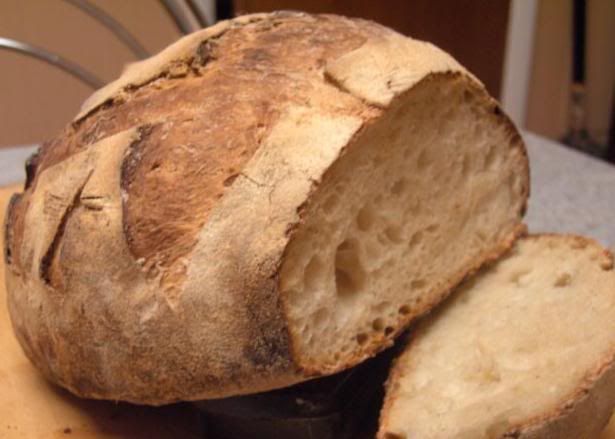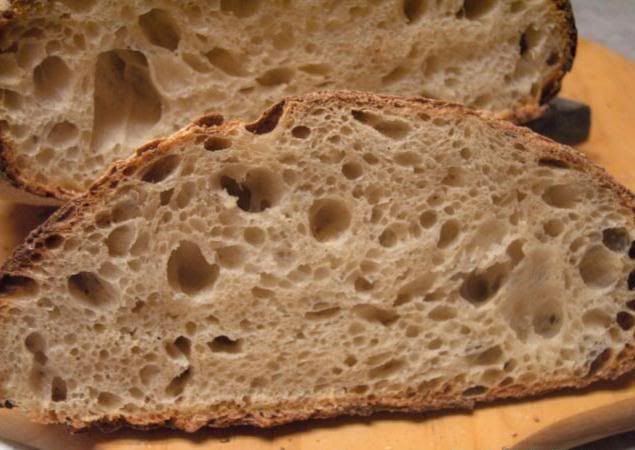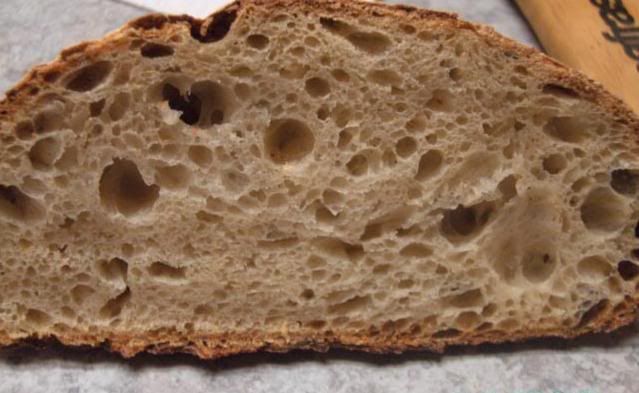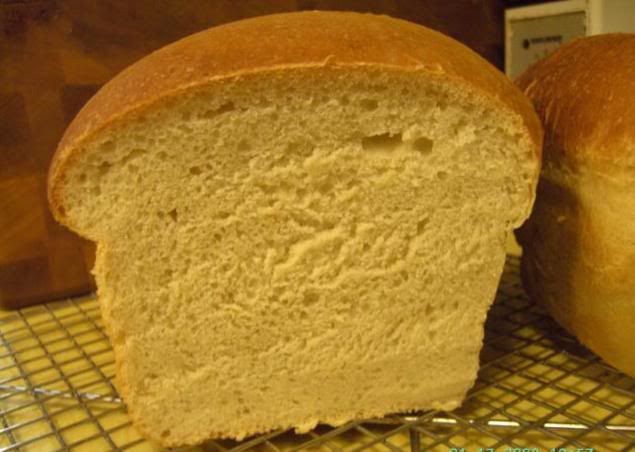Hi everyone, I'm a newbie here, so bear with me! :)
've got Nancy Silverton's grape starter about two days away from being ready, and I was just wondering..are there any other breads I can make with it besides her Rustic Loaf or Olive bread? In other words, can this be used in pretty much any sourdough or starter bread recipe? I know it's kind of a dumb question, but I seem to come across a lot of recipes where you have to add 'all' the starter or biga to the initial dough, but it's 'their' starter or biga, so no measured amounts, just add it all!.
Any recipes or advice will be greatly appreciated. :)
Hi Lisa, I too have a "Silverton grape starter". Are you doing it from Julia Child's book Cooking with Master Chefs, I thought maybe that's why you're referencing just those two recipes. Silverton also has a book out, Breads from the La Brea bakery. There are some good breads in there, LOTS of different ones that can be made with that starter. (although that book isn't as user-friendly or as well explained as some others).
BUT, you can pretty much make any sourdough bread with that also. I would just say one word of advice, is in my case, it took a little while and a few more feeds and builds to get that one really going to where I use it with no commercial yeast effectively. (I started also from the Julia Child book, and when I got her La Brea book I saw that she made more of an effort of feeding and building it also). I remember being disappointed way back when I started that one, to go through all that then just have those two recipes which both use commercial yeast. But it might be a good idea to bake with it a few times with a little spike of commercial yeast (in the bread dough recipe only, never put commercial yeast in the starter IMO), while you're really building the starter to get it in shape to when it can rise a bread by itself.
I like to measure my feedings by weight so I know what % the starter is as water and flour, then I can also adapt any recipe to use the starter (even ones that don't use starter at all), by doing some math on the water and flour.
Hope you soon enjoy the difference that comes with natural yeast sourdough. Most obvious difference to tell you I think is it takes longer to ferment and proof than a commercial yeast, but the flavor that results has a lot more going on.
Thanks so much for your awesome and informative reply, buns of steel (LOVE the nick!). That said, yes, I got it from the Master Chefs book, after seeing it on TV. One thing I noticed, like you mentioned, is that this starter is hard to really build up. Every time I feed it and let it sit at room temp, I get bubbles and a decent sour, yeasty scent, but it's a little thin, and not as 'active' as I'd like it to be. I think I'll probably end up feeding it for 4 to 6 days instead of the 3 she mentions after the initial 6 day ferment. I suppose I'll order her La Brea book, even though you mentioned that the recipes aren't well explained. I'm assuming it's a little more user friendly for people who have experience with breads and starters?
On another note..I also agree with your sentiment regarding adding commercial yeast after all that work on the starter. I'm not very fond of having to do that! The olive bread doesn't contain commercial yeast, so that was what I was going to tackle first. Do a lot of the breads in the La Brea book contain commercial yeast paired with starters?
~Lisa~
It's a good book with great breads, it's not in metric, no pics.
I remember there being a big difference in how she said to do it in the Child book, in La Brea she builds the starter differently. It's a 15 day process, on days 10-14 she feeds the starter three times a day. (feeding 1: 1/2 pound water, 5-1/2 oz flour, feeding 2: 1 pound water, 11 ounces flour, feeding 3- 2 pounds water, 1 pound 6 ounces flour) then each day keep only 1 pound 2 ounces of starter, throw the rest out and begin feeding again. In the Julia Child series she only feeds it once a day, and doesn't have you throw any out.
Lots of the breads in La Brea are starter only, and you'll find others and eventually learn how to bake anything you want with starter only as well. The olive bread lists yeast on the ingredients, then says it's optional. You'll have to make sure your new starter is well built before you'll have a successful result with starter alone. I wouldn't be afraid to use it with a little commercial yeast in recipes while it's building, to save some of the waste, or even baking with commercial yeast at first until the starter gathers strength from repeatedly baking with it and feeding it. You'll see when you start baking with it, if it has enough rising power yet to do the job alone.
Actually, I wouldn't mind no metrics, as I'm not very well versed in them. lol I use a scale too, but keep it on lbs and ounces!
That said, I didn't even take into consideration how much time, flour, and other ingredients (all those olives for the one bread) I would waste if the starter alone wasn't strong enough to rise the bread alone. Like I said, I think I'll feed it for 4 to 6 days more, and see where I'm at before I even think of using it alone.
Also, I accidentally left my starter out for 7 hours instead of 4 after feeding it. Complete brain freeze since we had to rush to meet some friends for dinner. That doesn't affect it negatively in any way, does it?
~Lisa~
Good to know! I'll let you know how then starter, and whatever bread I decide to make with it, turns out. :)
Buns, I had to tell you this. I added a cup of bottled spring water with the flour this morning when I fed my starter. I usually use tap water. OH MY GOD, my starter went nuts for it! I just took a look before putting it back in the fridge, and there were tons of foamy bubbles, kind of like when a wave breaks. I can only assume that maybe my tap water is too chlorinated? Oh, I also used a whisk (quick stir) instead of a spoon, which definitely aerated it more, spreading their meal around more than a spoon would.. (I think?). I've read that a steel whisk is ok, as long as it's used quickly, but never to store the starter in a metal bowl, as the reactive nature would kill the starter.
OK..I made my first breads with Nancy Silverton's grape starter. The first one is a basic sourdough using 1 cup starter, 3 cups Bread Flour, 1 cup water, and 2 tsps salt. The second one is a softer, Sourdough-potato-oatmeal sandwich type bread, (with a tighter crumb, even though I did not add any commercial yeast -only the starter) baked in a loaf pan.
Quick note regarding the basic loaf, my pilot light went out 15-20 minutes into baking it (some of the boiling water I threw into the cast iron pan put it out, but I didn't realize it until I checked on it 15 minutes into baking). It was rising perfectly, so I had a big white bread of undone Sourdough. I had to relight the oven, let it preheat, then throw it back in. Unfortunately, it overcooked a little, leaving the crust a little harder and tougher than I like (I like a crispy, crackly crust), and browned a little too much. Regardless, it still tasted wonderful!




BTW, I hope I did the photo thing right. They seem a little too big. Please let me know if there is anything I can do to make them a little more viewable and spaced, using the upload tool here. :)
nice crumb on the freestanding loaf, especially for the first bake, guess your starter is ready to rock!
if you want a cheap way to un-chlorinate your municipal tap water, if you leave it out on the counter in a bowl, the chlorine will evaporate off from it, you can stir occasionally.
I just made silverton's sourdough pancakes last weekend, easy and light. If you got your book I recommend them, more fun with your Silverton starter :). Just beware that the batter bubbles up like mad when you add the baking powder/soda, I wasn't expecting so much of that, and it overflowed the bowl I was using and I was scrambling to contain it.
Thanks, buns. I was very happy with it, but now I'm at the point where I have too much starter, and no one I know is into baking enough to invest any time in the care and feeding of it. I know you can discard (or make pancakes) a certain amount, but then you have to replenish it with the exact amounts of flour and water that was taken out. SO, my question is..what is the proper way to do this so I have a manageable amount of starter (I bake bread maybe once a week or once every two weeks)? I'm definitely going to dry some, just in case something happens to my refrigerated starter, and I know you spread it out on some parchment to dry, then store in a bag, but should that be kept in the fridge, or can it remain at room temp in a cupboard? OK..I'm so sorry for so many questions, but I have one more..LOL
About the tap water..can I pour it into an empty gallon spring water bottle, and leave it open overnight..or is the opening too small for the chlorine to disappear? If it's ok, is it ok to keep my now 'dechlorinated' water in that bottle at room temp for starter feedings and baking with the starter?
Again, so sorry for so many questions, but thanks in advance. :)
I think you need some surface area for the chlorine to come out as a gas. So if you half filled that, it'd probably work, as long as the air in the other half of the container got exchanged. I wouldn't store water at room temp for greatly extended periods of time, but for a little while it's fine, if you want to store for long, refrigerate it IMO.
You'll have to find your own way with how to keep the right amount of starter. It can't go two weeks without feeding IMO without losing quality. As for the parchment I know you can do that but I never have.
Are you sure you're only going to bake that rarely.... it can get addictive especially on your way up the learning curve when you want to try all these different things. Then you also start to feel responsible to the yeast to keep them happy ;)
Thanks so much for your answers :) I'm definitely going to keep feeding and nurturing it, as I'd be crazy not to, considering it's got some good steam so early on. Thing is, as of now, yes, I'm addicted, and have another loaf rising at the moment..lol, AND want to try all kinds of starter breads (I'll be ordering her La Brea book, and Peter Reinhart's book next week), but even when you take some out for baking, you're putting it right back to where it was before. Nancy Silverton says after a few months, discard all but two cups, and feed again. Thing is..how much? 1 cup each of water and flour, or 2 cups each? I don't want to risk losing this starter due to some feeding or replenishing mistake.
Two more questions. When you feed it, do you have to let it sit out and bubble before putting it back in the fridge, or is that only when you're going to bake? I interpreted 'feedings' to mean you take them out of the fridge once every two weeks, give them a feeding, then put them right back in the fridge. Also, some books and sites say you should punch a hole in the cover of the container you store your starter in, and some say keep it airtight, in the fridge. Opinion?
God..I'm such a novice. I've done starters before, but they never worked like this one *then again, my interest wasn't as intense back then*, and I always ended up forgetting about them, leading to their demise. Bigas/Poolishes were more on my level. Quick, and usually used up in one shot.
I'm relatively new to the starter thing as well, but what has been working for me (and I have an erratic baking schedule) is to maintain the starter by discarding all but a Tbsp (I keep discards in the fridge and make pizza dough to freeze when I hit a cup or so) of about 1/4 c flour to a very scant 1/4 c water. This keeps both starter levels and discard levels manageable.
When I plan on baking, I keep to the same feeding schedule, but instead of dumping the discards in my fridge container, I feed that as well (obviously, a bit more starter, so more flour & water--more like 1/2c flour to 1/3c water), and let them both double overnight. Then I can use the larger quantity for baking while my mother starter stays at a constant size. It seems to activate the yeast nicely before baking, and it generally produces enough active starter for any recipe I'm interested in. If I am going to bake more, I can keep doing this, or I can put the doubled starter back in the fridge until next time. (Although, in the interest of yeast caretaking, I've been trying to do at least 2 feeds before making them hibernate again....)
Hope this helps! Good luck & your bread looks delicious.